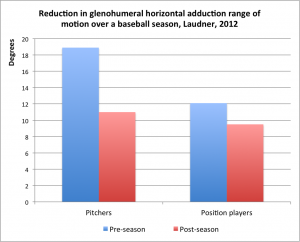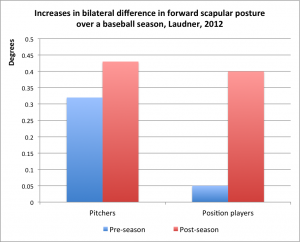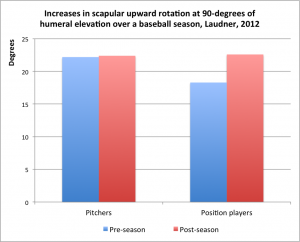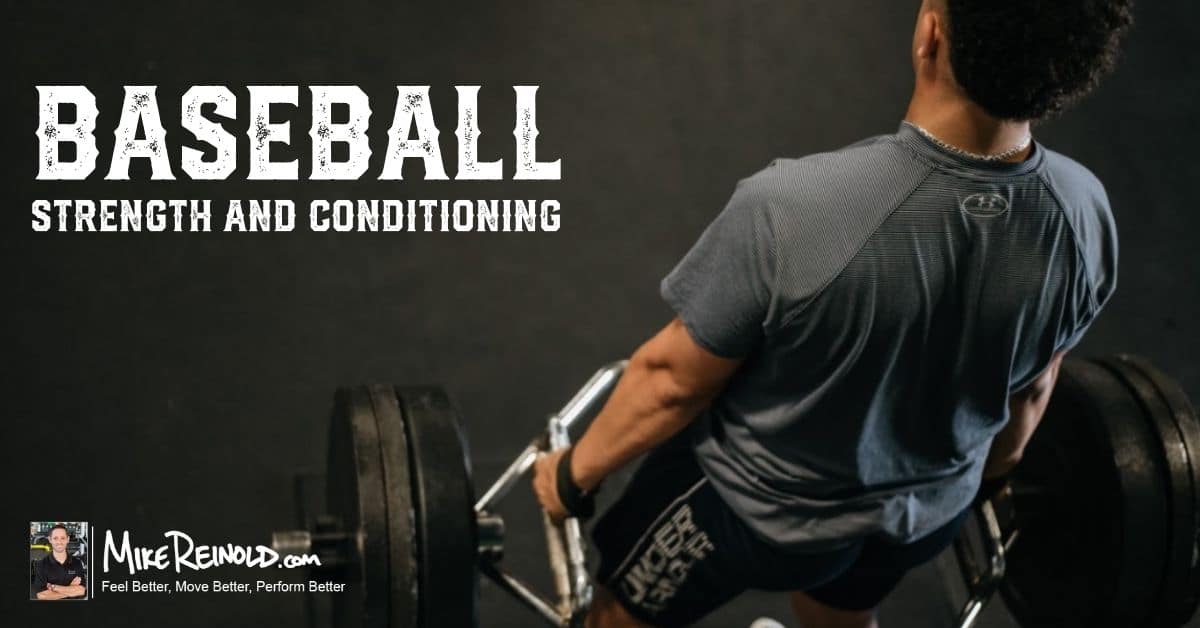Today’s guest post by Chris Beardsley is a review of a recent study looking at the changes in shoulder joint range-of-motion that baseball players experience over the course of a season. A timely post as the MLB season winds down.
The Study
Shoulder Adaptations Among Pitchers and Position Players Over the Course of a Competitive Baseball Season, by Laudner, Lynall and Meister, in Clinical Journal of Sports Medicine, 2012 [Pubmed]
Background
Baseball position players typically play daily during game season and while pitchers throw in games less frequently, they often throw on their rest days. Consequently, upper extremity injuries are common in baseball players, particularly among pitchers. And despite advances in both rehabilitation knowledge and surgical technology, the trend for such injuries appears to be increasing.
Researchers investigating upper extremity injuries in baseball players have previously reported alterations in shoulder function such as posterior shoulder tightness and scapular dyskinesis, both of which have been associated with a variety of shoulder pathologies.
What did the researchers do?
The researchers wanted to investigate whether posterior shoulder tightness and scapular position change over the course of a competitive baseball season in both baseball pitchers and in position players. So they recruited 16 asymptomatic, professional baseball pitchers and 16 asymptomatic, professional baseball position players. Neither group had any history of upper extremity injury in the last 6 months nor any history of upper extremity surgery.
The researchers measured scapular upward rotation and glenohumeral range of motion (ROM) using a digital inclinometer. They measured glenohumeral horizontal adduction ROM with the subjects supine on a table and the shoulder in 90 degrees of abduction and flexion with the scapula stabilized using a posterior force into the table. They measured bilateral glenohumeral internal rotation ROM in a similar set-up: in the supine position with the shoulder in 90 degrees of abduction and flexion and the scapula stabilized using a posterior force into the table.
The researchers measured bilateral forward scapular posture with the subjects standing against a wall and used the double-square method to establish the distance between the wall and the acromion of the scapula. They recorded the difference between the throwing and non-throwing arms for analysis. Finally, they measured scapular upward rotation of the throwing arm in a resting position as well as in the scapular plane at 60, 90, and 120 degrees of humeral elevation.
The researchers performed these measurements at two points in time: at the baseball players’ initial physical examination during spring training and within the final week of their competitive season.
What happened?
Glenohumeral horizontal adduction ROM
The researchers found that were no significant differences in the changes to glenohumeral horizontal adduction ROM between pitchers and position players over the course of the season. However, there was a trend for the pitchers to start the season with a greater ROM than position players, while the ROM at the end of the season was similar in both groups of players. This was caused by a reduction in the ROM of the pitchers.
Bilateral internal rotation ROM
The researchers found that were no significant differences in the changes in bilateral internal rotation ROM between the pitchers and the position players over the course of the season. However, there was again a trend for the pitchers to start the season with a greater ROM than position players, while the ROM at the end of the season was similar in both groups of players. This was caused by a reduction in the ROM of the pitchers.
Bilateral difference in forward scapular posture
The researchers did not note any significant differences in the changes to the bilateral difference of forward scapular posture between the pitchers and the position players over the course of the season. However, there was a trend for the pitchers to start the season with a greater ROM than position players, while the ROM at the end of the season was similar in both groups of players. This was caused by an increase in the ROM of the position players.
Scapular upward rotation
The researchers found that the pitchers displayed significantly lower increases in scapular upward rotation at 60 and 90 degrees of humeral elevation compared with the position players as a result of the baseball season. However, this appeared to result from the pitchers starting the season with a higher level of upward rotation and both groups finishing the season with similar degrees of upward rotation.
What did the researchers conclude?
The researchers concluded that pitchers developed significantly less scapular upward rotation at 60 and 90 degrees of humeral elevation over the course of a competitive baseball season compared with position players. The researchers propose that the increase in scapular upward rotation displayed by the position players may be a beneficial adaptation geared towards reducing their injury risk.
The researchers suggest that the absence of a similar increase in pitchers may make them more susceptible to shoulder injuries. However, it is important to note that the pitchers started the season displaying significantly greater levels of scapular upward rotation and the season only serves to bring the position players up to a similar level. An alternative interpretation of the results is therefore that the pitchers already have such adaptations, beneficial or not, and that the season’s activities bring the position players up to a similar level. Whether these adaptations are genetically determined or acquired over time is unclear.
Indeed, the researchers note that since posterior shoulder tightness causes the humerus to translate upwards into the subacromial space, it is possible that athletes perform increased scapular upward rotation in order to elevate the acromion and increase the available subacromial space. Therefore, it is possible that the adaptive process that was observed in this study in the position players was done for this reason and it is also possible that the pitchers did not require this adaptation, having sufficient subacromial space already.
Limitations
This study was clearly limited by the small sample size that precluded the observation of several large differences in the measured variables between position players and pitchers over the course of the season.
Key Points
Pitchers develop significantly less scapular upward rotation at 60 and 90 degrees of humeral elevation over the course of a competitive baseball season compared with position players. However, the increase in scapular upward rotation observed in the position players only brings their total amount of movement in line with the pitchers, who begin the season with a greater degree of upward rotation.
Mike’s Thoughts
Thanks Chris, I thought you did a great job summarizing this nice article. Studies like this are extremely challenging to perform, more so than you would think. There is inherently an issue with control over the course of a season. Did every pitch the exact same amount of innings and games? Did they all throw with the same velocity? Since this is a ROM study, did they all stretch exactly the same and with the same exact frequency all season?
The answer to all of these questions is, “of course not.” This is what makes this so challenging, we can only take the means of a large group and try to draw conclusions. I do caution readers to take information like this with a grain of salt.
As my readers know, I work in baseball everyday, yet I seldom discuss baseball on this website. I am not in a position that I can share all I have learned (yet at least!), but I can tell you that we have studied very similar trends as this study. Players will loose motion over the course of a season, similar to what we showed acutely after one outing (see here and here). The acute ROM changes can become cumulative over the course of a season. However, a proper stretching program can maintain normal ROM over the course of a season.
About the author

[hr]
If you enjoyed this post, then you’ll love Strength and Conditioning Research, a monthly publication that summarizes recent journal publications just like this post. Don’t let the name fool you, there are a ton of research reviews for rehabilitation as well. Chris does an awesome job summarizing a ton of great articles every month. I am a proud subscriber because it helps me stay current and I can read it on my iPad when I am on the go. Learn more about Strength and Conditioning Research.










